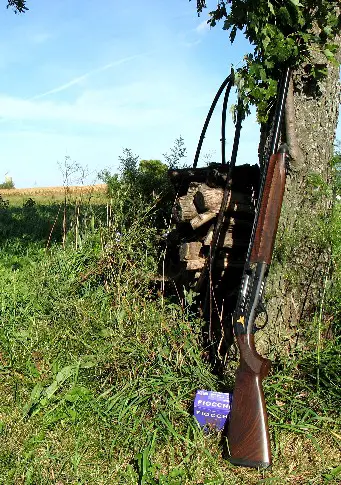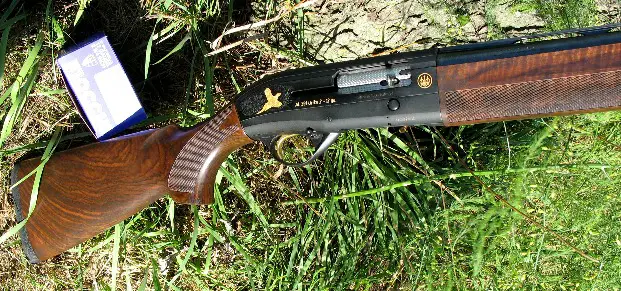


2007 Beretta AL391 Urika 2 Gold 12 Gauge Shotgun

It has been a long,
long wait . . . but the Beretta Urika 2 Gold covered in a SHOT show preview
finally arrived. Twelve gauge, three inch chambers, Optima 28 inch barrel
and chokes, it is one of the most popular 12 gauge semi-auto configurations
and identical to the gun I enjoyed shooting in Orlando.
To say that the Beretta 303 / 390 / 391 series is a model line heavily used by me over the years would be an tremendous understatement; countless models have come and gone from my working repertoire. Right now, as this is written, three Browning B-80's, one Beretta A303, and two Beretta A390's are in my safes that see regular, if not weekly use.
The tested Urika 2 12/28 weighs 7 pounds, 15 ounces. To compare this to identically barreled guns, my AL390 Gold Mallard weighs 8 pounds on the nose and my AL 390 DU 12 gauge weighs 8 pounds, 4 ounces. Both of the 390's have the steel fore end nut and semi-humpback receiver; so there essentially no weight difference worth talking about. The steel receivered B-80 12 gauges, as you would imagine, are a bit heavier at 8 lbs. 9 ounces. So, to characterize 390's and 391 as approximately eight pound guns seems a reasonable comment.
Of note is the factory trigger on the Urika 2, breaking cleanly at from 4 lbs. 4 oz. to 4 lbs. 9 oz. I can't compare this to my other 303 / 390 genre guns, as it is easy for me to tell you which of the other ones have had trigger work: all of them have. Those of you familiar with my writings know full well that I find triggers that are heavier than the shotguns themselves repugnant. This is the first semi-auto I have tested in a long, long while that has an excellent hunting trigger on it right out of the box; I'm thankful for that.
Invariably, the subject of "felt recoil" comes up. Naturally, there is no clever answer beyond physics . . . we all feel our own recoil, no one else. All of the 303 / 390 / 391 shotguns have always been very soft shooters as far as I'm concerned. So-called back boring and forcing cone work has nothing at all to do with recoil, nor does peak pressure in a shotshell load. Sooner or later, most of us figure that out. Of all the 12 gauges, the softest shooter with 1200 fps 1-1/8 oz. loads remains the old steel receiver Browning B-80: a gun that weighs about three quarters of a pound more. It is that nasty physics thing, again, that creeps in when we least expect it.
I dropped quite a few doves using Fiocchi 1 oz. 1250 fps "Little Rhino" loads in #7-1/2 shot; just a great load for this gun that you want to shoot all day. I did just that. On the other end of the spectrum, I shot some 3 inch Fiocchi 1-3/4 oz. "Golden Pheasant" loads as well. As you can imagine, a steady diet of these blew me around a bit after a while. I can tell you that 1-3/4 oz. of #5 Fiocchi nickel-plated shot rips a dove out of the sky at a laser-verified 65 yards with absolute authority, however! That is the range of shells fed to the Urika 2 so far, along with batches of my 1-1/8 oz. American Select and Green Dot reloads-not a single failure to eject or failure to feed thus far.
Cosmetically, the Urika 2 Gold is a stunner. The oil-finished wood is well-figured, darkly stained, and the fore end is evenly matched in color and tone with the buttstock. My sole complaint is the cheesy "Optima" lettering pressed into the bottom of the forearm; an unsightly and needless distraction. Unlike the 390's, the Urika 2 has no pistol grip cap which is of no particular importance to me. The rest of the gun has enough very tasteful styling accents, including the jeweled bolt and trigger-guard like my Gold Mallards, to make it no less than a gorgeous shotgun.
I've not cleaned the Urika 2 action yet; as this gun will be used heavily for patterning tests of a wide variety of loads, I'm going to see what it takes to get it to jam. The serrated gas piston is claimed to increase reliability by 40% and reduce maintenance by 50%. Well, I've never had any reliability issues with the 303 / 390 / 391 line, so increasing total reliability by 50% is going to be difficult to quantify. If it does indeed inhibit gas-action carbon build-up over thousands of shots, I'll certainly report that as best as I am able.
I won't try to call the Urika 2 "Revolutionary," as there is really no basis for it. The fundamental action has always been miles ahead of the O ring disasters that have populated semi-auto shotguns for a long while. The 302 / 303 series action was always a good one, with the sole caveat that it was non-compensating. The more gas flow through the ports, the more bolt speed you tend to get. When some of us tried to turn 12 gauge loads into 20 gauge loads (an odd trend that still continues), out came the drill bits for the impotent super-light loads, and on the other end of the spectrum a barrel change was required (to 3 in. chambers) to reduce the bolt speed on the gassier 1-1/4 to 1-1/2 oz. loads, and naturally to use 3 inch unfolded length hulls.
Times have changed, though, and many of us cannot bear the thought of a friction ring adjustment (A-5) or tuning our gas semi-autos to get the proper 6 - 8 foot hull ejection distance. So, we want 12 gauges that handle 28 ga. payloads as well as what was once considered 10 gauge payloads without any adjustments. It is asking a lot, most semi-auto rifles and pistols sure can't tolerate such load diversity, but we want it anyway.
Beretta answered that with the 390, the spring attenuated secondary fore arm gas vent neatly giving us 1 oz. to 1-7/8 oz. (and heavier) capability. It was and is a very competent approach, something really so good it wouldn't go away as evidenced by the reintroduction of a version of the 390, the 3901 series made in the USA.
The Urika 2 fit me so well out of the box, I didn't need to think about swapping shims (included in the plastic Beretta hard case) along with a total of five Optima chokes. It is really, really hard to miss with this gun. Folks tend to ask the same questions, so I'll answer them as best I can: no, the Beretta "Optima" barrels do nothing to improve patterning or felt recoil-nor do any other factory overbored barrels, regardless of brand. The only thing can say about them is that they have screwed up the notion of choke constriction for a lot of people, as there can be no known exact constriction unless you know your individual guns bore diameter and the exit diameter of the individual conical-parallel choke tube. Then, it still does not translate to any pattern percentage-we still have to pattern, as the specific shell we use can and does change everything. The residual gas pressure existing at the muzzle of a shotgun makes porting another nonsensical notion (in shotguns) having the effect of selling more hearing aids than anything else. I'm very pleased that the Urika 2 tested has no needless holes in the sides of the barrel.
Many folks, myself included, wondered what was "broken" on the Beretta 390 that begged to be fixed? The answer was, and is, nothing of great importance. That said, a great deal of over-engineering went into the 391 forearm nut. A horribly complex, parts-intensive little goblin, it has more parts to it (seven) than the 303 genre gas system itself. It was decided that a slimmer forearm made the shotgun more appealing, and the 391 accomplished that. By now, with something approaching 1.7 million shotguns sold, it seems clear that whether rational or not, Beretta made no great mistake. It does feel a small bit livelier in the hands than my 390's, if anything, and makes the gun appear a small bit more streamlined . . . both completely subjective impressions.
There is no true "all-round shotgun;" if there was such as thing I'd have a lot more space in the safes than I do currently. The Urika 2 comes as close to it as any shotgun currently available, though. Whether skeet, trap, sporting clays, dove, duck, pheasant, or turkey . . . this gun is more than capable of handling the task.

Long a devotee of
Beretta 12 gauge gas guns, having hunted high volume dove, duck, and snow
geese with them, as well as weekly (sometimes nightly) clays work,
this gun will please most folks who are avid shooters. Shim-adjustable
long before it was common, Beretta continues to offer that while some
others just don't get it, soft-shooting, non-fussy about what you feed
it, and at last a factory trigger that is fine as is out of the box .
. . this is a wonderful shotgun, with enough bells, whistles, and handsome
good looks to make most wingshooters extremely happy for many years. I
know I am; I think you will be as well.
Copyright 2007 by Randy Wakeman. All Rights Reserved.
Copyright 2011 by Randy Wakeman. All Rights Reserved.

Custom Search




